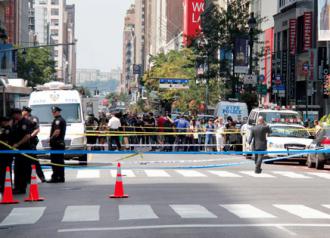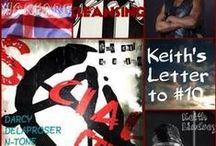The New York Police Department has adopted the motto: Shoot first--and often--and ask questions later, report
September 10, 2012
 New York police block off the street after the shooting outside the Empire State building
New York police block off the street after the shooting outside the Empire State building
POLICE IN New York City opened fire wildly in two high-profile mass
shootings in August, with deadly results--providing yet more evidence
that the NYPD represents a threat to the public's safety that it is
supposed to be protecting.
And proving that the August shootings weren't the exceptions, the
NYPD struck again on September 7, killing a worker at a Bronx bodega as
he fled an armed robbery.
Across the country, there has been a wave of shootings where police
used deadly force in full public view and with impunity. But even so,
the violence unleashed by the shoot-first-and-ask-questions-later NYPD
has been shocking.
The deadly confrontation with Darrius Kennedy, an African American
man, began in tourist packed Times Square on August 11. Police
approached the 51-year-old who was smoking marijuana and asked for
identification. Kennedy became angry and pulled out a kitchen knife. No
doubt his anger was triggered at least in part from having been arrested
10 times--seven of them for marijuana possession.
Police knew they were dealing with an unstable man because Kennedy
had been arrested in 2008 for threatening officers with a screwdriver.
He had also been admitted to Bellevue Hospital for acting strangely in
Times Square.
In a scene straight out of some TV cop show, Kennedy--armed only with
the knife--skipped backward down Seventh Avenue with over 20 cops, guns
drawn, and police cruisers in hot pursuit. Pandemonium ensued, and
hundreds of terrified people ran for cover--others watched and recorded
the unfolding drama with cell phone cameras.
Kennedy taunted the officers and refused to drop the knife, despite
being pepper-sprayed six times. Police claimed he lunged at them, and
they fired 12 shots at Kennedy, hitting him in the chest, arm, groin and
leg. Kennedy died at the hospital from his wounds.
Police Commissioner Ray Kelly and Mayor Michael Bloomberg were quick
to justify the behavior of police. They claimed the officers acted in
self-defense--as if one man with a kitchen knife was a serious threat to
20 police officers brandishing semi-automatic pistols. Neither Kelly
nor Bloomberg nor anyone in the media asked why the highly trained "New
York's Finest" couldn't disarm or deescalate a mentally disturbed man
without pumping his body full of bullets?
"You can second-guess all of these things," said Kelly. "Under the
circumstances, what the officers did was appropriate to the situation.
They want to go home at night as well. The individual was threatening
people, threatening officers."
But Kennedy was obviously no match for 20 cops. When he was alive, he
was homeless, unemployed and clearly cracking under the pressure of an
untreated mental illness and police harassment, enduring arrests on
marijuana possession charges that even politicians now believe should be
taken off the books, or at least decriminalized.
There was no compassion for Kennedy in the mainstream media, however--nor any criticism of NYPD's wild shooting spree. The New York Post called Kennedy a "knife-wielding maniac" and an "armed madman" who was justifiably "put down."
Kennedy's family members were among the few people who questioned the
cops' actions and why they fired so many shots. Kennedy's aunt, Mary
Johnson, told the New York Times, "This could have been handled
in a different way. It doesn't take 12 or 15 bullets to kill a horse, so
it wouldn't take that many to kill a person."
- - - - - - - - - - - - - - - -
THE SECOND mass police shooting came two weeks later. Minutes after
58-year-old Jeffrey Johnson killed former co-worker Steven Ercolino in a
tragic workplace-related shooting, the New York police opened up again
with a barrage of bullets in front of the Empire State Building. Johnson
was shot dead--and nine bystanders were wounded by cops who fired a
total of 16 rounds on a sidewalk crowded with people.
Press reports at first attributed the injuries to Johnson, but the
media later admitted the cops were responsible for each and every injury
after Ercolino. So how could NYPD officers, who have extensive weapons
training, end up shooting so many innocent bystanders?
Once again, the police department, the mayor and the media justified
police actions. Asked why so many people were shot, an officer stationed
at the Empire State Building said several days later in an interview:
"It was a frantic situation and they were being nosy--not that they
deserved to be shot."
A New York Times article quoted one of the shooting survivors
saying he couldn't "get really mad at the cops," and Johnson's
80-year-old mother told a reporter, "I don't blame police in New York
for shooting my son, because he killed somebody."
But the trigger-happy response outside New York City's most famous
building mirrors incidents over the years in other parts of the city,
especially neighborhoods where people of color predominate. The phrase
"hail of bullets" is synonymous with many of these shootings--the NYPD
fired 41 bullets at the unarmed Amadou Diallo, 50 at Sean Bell and 73 at
Leroy Webster.
The truth is that there's nothing to stop New York police from using
maximum force in confronting a "threat"--because the odds are that they
won't be punished, even if they kill innocent people and even if a video
exposes them using excessive force. The cops know that they will be
backed up by NYPD officials and political leaders like Bloomberg.
Furthermore, the killings of Kennedy and Johnson exemplify how
unemployment, untreated mental illness and the war on drugs combine to
create violent conflicts between police and the most vulnerable people
in society.
New York City is the marijuana arrest capital of the world. More
people are arrested for this "crime" than any other--it's one of the
main ways that NYPD officers meet arrest quotas. In 2011, the NYPD made
more than 50,000 arrests for marijuana possession. Darrius Kennedy was a
victim of the racist drug war that disproportionately targets poor,
Black men and punishes drug users. If marijuana was legal and regulated
like tobacco and alcohol--which is what a majority of Americans say they
want, according to polls--Kennedy might be alive today.
Meanwhile, Jeffrey Johnson was also mentally unstable, living a life
of desperation that was no doubt exacerbated by two years of
unemployment and the death of a beloved cat--his constant and apparently
only companion. Every day, according to the doorman of Johnson's Upper
East Side building, he left his apartment at exactly the same time,
dressed in the same beige suit and brown shoes, as if he were going to
work. Instead, Johnson went to McDonalds for breakfast. It's likely that
when Johnson lost his full-time job, he lost health coverage, and
therefore access to mental health services that could have helped him.
- - - - - - - - - - - - - - - -
LAST FRIDAY'S shooting in the Bronx took place outside Nathalie Deli,
a small bodega in the Morrisania section of the Bronx. Twenty-year-old
Reynaldo Cuevas and his uncle were working at the store when it was held
up in a robbery. As Cuevas ran outside, hoping to escape, he bumped
into a police officer, who shot him point blank in the left shoulder.
Cuevas died instantaneously.
Not only did the NYPD kill another innocent man--a father of a
3-year-old and a respected member of the community--but they proceeded
to drag Cuevas' dead body across the street and handcuffed his corpse in
a display of gruesome inhumanity.
Nearly 100 people gathered in on the streets of Morrisania that night
to mourn another victim of police terror. "I can't even believe it,"
said Cuevas' cousin Mickey Rodriguez. "They shouldn't have shot a
defenseless man without a weapon. It happens all the time nowadays. I
feel more scared of the cops than the people in the street because they
might shoot me right away."
Another cousin, Giselle Guzman, described how Reynaldo had been trying to persevere through a series of family tragedies:
He tried his best to take care of his daughter. He lost his father--he was shot in the DR--and he lost his sister to a heart attack last year. It makes me feel horrible because we have people in our family serving in the NYPD, and they did a horrible thing. They don't make me feel safe at all. If anything, they make me feel more unsafe. Having a weapon doesn't mean you have to shoot at someone who had nothing to do with it.
A small memorial was set up near the bodega with posters written by
friends and families, prayer candles, and people singing and playing
music. As more people joined the demonstration, the NYPD warned the
community that they were "too loud" and would "attract attention."
This incensed the crowd further, and people took the streets,
marching to the 42nd Precinct, where the officer who shot Reynaldo now
sits on administrative duty. It speaks to the nature of our society that
while a family and a community have a loved one ripped from their
lives, the police officer responsible essentially gets a paid vacation.
As Robert Ali, a customer of the Nathalie Deli, said:
I don't feel safe around them, and I don't feel like my kids are safe around them. It's just, like, more shit on top of more shit on top of more shit. After a while the cup is going to spill over and people are going to go crazy. We can't take it any more. We need to unite, black, brown, white, as one instead of killing each other, and if we don't unite, we are going to die. We are going to be extinct.
In a city where 35,000 cops patrol the streets, subways and projects
every day, more violent and lethal confrontations between the NYPD and
people struggling to survive--or who happen to be in the wrong place at
the wrong time--are inevitable. Trigger-happy police are everywhere in
New York City, and they are getting away with murder.

No comments:
Post a Comment